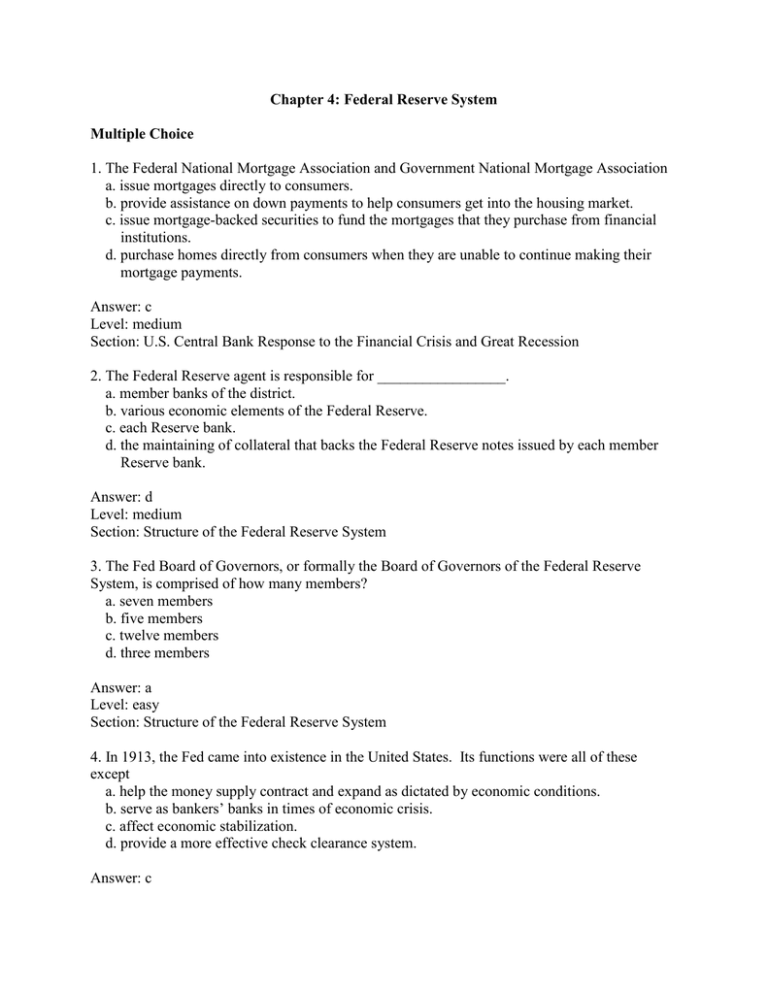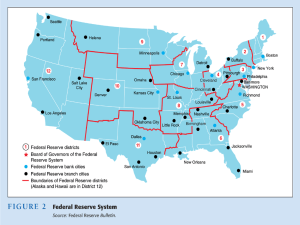Chapter 4: Federal Reserve System Multiple Choice 1. The Federal
advertisement

Chapter 4: Federal Reserve System Multiple Choice 1. The Federal National Mortgage Association and Government National Mortgage Association a. issue mortgages directly to consumers. b. provide assistance on down payments to help consumers get into the housing market. c. issue mortgage-backed securities to fund the mortgages that they purchase from financial institutions. d. purchase homes directly from consumers when they are unable to continue making their mortgage payments. Answer: c Level: medium Section: U.S. Central Bank Response to the Financial Crisis and Great Recession 2. The Federal Reserve agent is responsible for _________________. a. member banks of the district. b. various economic elements of the Federal Reserve. c. each Reserve bank. d. the maintaining of collateral that backs the Federal Reserve notes issued by each member Reserve bank. Answer: d Level: medium Section: Structure of the Federal Reserve System 3. The Fed Board of Governors, or formally the Board of Governors of the Federal Reserve System, is comprised of how many members? a. seven members b. five members c. twelve members d. three members Answer: a Level: easy Section: Structure of the Federal Reserve System 4. In 1913, the Fed came into existence in the United States. Its functions were all of these except a. help the money supply contract and expand as dictated by economic conditions. b. serve as bankers’ banks in times of economic crisis. c. affect economic stabilization. d. provide a more effective check clearance system. Answer: c Level: difficult Section: Monetary Policy Functions and Instruments 5. Which of the following policy instruments could the Fed use as a form of expansionary monetary policy? a. raise member banks’ reserve requirements b. raise taxes on households c. sell securities in the open market d. purchase securities in the open market Answer: d Level: difficult Section: Monetary Policy Functions and Instruments 6. The banking system of the United States is a fractional reserve system because __________. a. banks are required by the Fed to hold reserves equal to a specified percentage of their deposits. b. that system allows the size of the money supply to influence the Fed’s broader economic objectives. c. the amount of reserves can be affected directly through open market operations. d. the nation’s banks are in an overly liquid position because of excessive reserves. Answer: a Level: difficult Section: Monetary Policy Functions and Instruments 7. The supervision of commercial banks and other depository institutions is primarily concerned with what aspect of the banking system? a. to ensure the safety and soundness of individual institutions b. chartered member banks c. the federal funds rate d. supervising and regulating depository institutions that are not commercial banks Answer: a Level: difficult Section: Fed Supervisory and Regulatory Functions 8. The Fed approves or denies the acquisitions of banks and other closely related nonbanking activities by bank holding companies. They permit or reject changes of control and mergers of banks and bank holding companies under all of those acts except ____________________. a. the Bank Holding Company Act of 1956 b. the Bank Merger Act of 1960 c. the Glass Steagall Act of 1933 d. the Change in Bank Control Act of 1978. Answer: c Level: medium Section: Fed Supervisory and Regulatory Function 9. Through which act of Congress did the Federal Reserve encourage depository institutions to help meet the credit needs of their communities for housing and other purposes while maintaining safe and sound operations? a. the Community Reinvestment Act of 1977 b. the Bank Merger Act of 1960 c. Bank Holding Company Act of 1956 d. Glass Steagall Act of 1933 Answer: a Level: easy Section: Fed Supervisory and Regulatory Functions 10. The Reserve Banks provide a wide range of important services to depository institutions and to the U.S. government. Choose an example from the list below: a. encourages depository institutions to help meet the credit needs of their communities b. give consumers the ability to compare costs of alternate forms of credit c. the payments mechanism, a system whereby billions of dollars are transferred each day d. writing rule or enforcing a number of major laws that offer consumers protection in their financial dealings Answer: d Level: difficult Section: Fed Service Functions 11. Virtually all currency in circulation is in the form of what exchange medium? a. coins b. checking account deposits c. gold d. Federal Reserve notes Answer: d Level: easy Section: Fed Service Functions 12. The federal government makes most of its payments to the public from _____________. a. international organizations such as the International Monetary Fund b. funds on deposit at the Reserve Banks c. Federal Reserve notes d. settlement funds Answer: b Level: medium Section: Fed Service Functions 13. In countries where central banks are relatively independent from their governments, there have generally been a. lower inflation rates. b. higher inflation rates. c. lower economic growth rates. d. more incidents of insolvency. Answer: a Level: difficult Section: Central Banks in Other Countries 14. The European Central Bank (ECB) conducts monetary policy for the twelve European countries that formed the European Monetary Union and adopted what common currency? a. dollar b. euro c. ruble d. yen Answer: b Level: easy Section: Central Banks in Other Countries 15. The Bank of England (BOE) is managed by a. parliament b. nine trustees c. a governor and five additional officers d. the Fed Answer: c Level: medium Section: Central Banks in Other Countries








